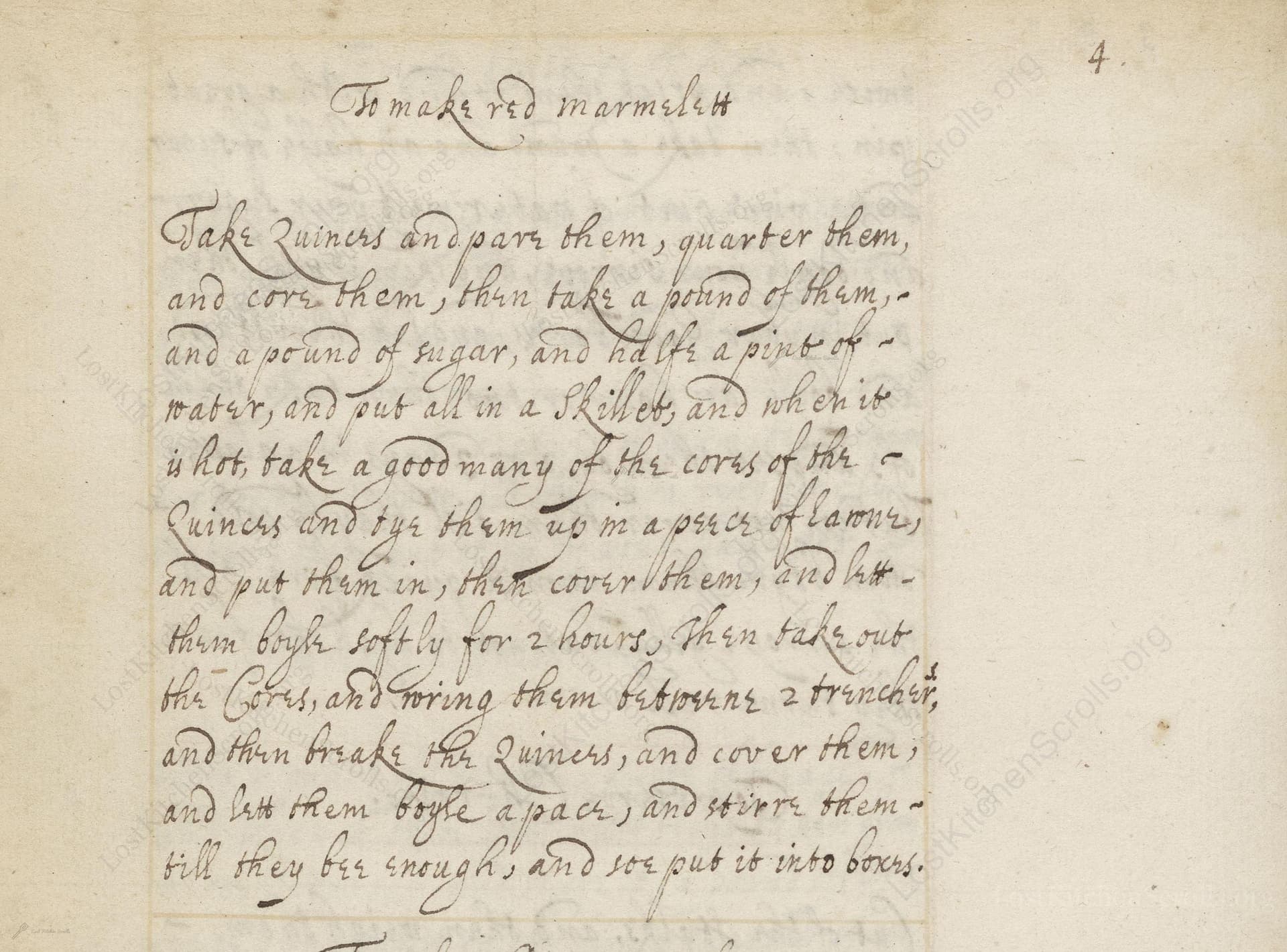To Make Red Marmelatt
From the treasured pages of Receipt book of Sarah Longe
Written by Sarah Longe

To Make Red Marmelatt
"Take Quiners and pare them, quarter them, and core them, then take a pound of them,- and a pound of sugar, and halfe a pint of - water, and put all in a Skillet, and when it is hot, take a good many of the cores of the - Quiners and tye them up in a peece of lawn, and put them in with the cores of them, and lett them boyle softly for 2 hours, then take out the Cores, and wringe them betwenr 2 trencher, and then breake the Quiners, and cover them, and stirre them a good space, and stirre them - well till they ber enough, and soe put it into boxes."
Note on the Original Text
This recipe, like many of its era, is written as a set of working instructions rather than a precise formula. Quantities are given per batch, but times and outcomes rely on the cook’s experience. Words like 'Quiners' mean 'quinces', while 'pare', 'quarter', and 'core' show the hands-on nature of early modern culinary texts. Spelling is non-standard ('marmelatt', 'tye', 'lett', etc.), and the instructions presume familiarity with both equipment and the look and feel of finished preserves. The recipe’s structure is conversational, walking the cook step-by-step through a familiar seasonal task.

Title
Receipt book of Sarah Longe (1610)
You can also click the book image above to peruse the original tome
Writer
Sarah Longe
Era
1610
Publisher
Unknown
Background
A delightful glimpse into early 17th-century kitchens, this collection by Sarah Longe whisks readers through ancestral recipes, cooking tips, and the seasonings that graced the tables of Jacobean England. Prepare to savor the tastes and traditions of times gone by.
Kindly made available by
Folger Shakespeare Library
This recipe comes from the early seventeenth century, attributed to Sarah Longe around 1610. At the time, quinces were highly prized for preserves and popular as elegant table sweets in aristocratic and wealthy households. Marmalade then referred to a firm, sliceable paste, not the spreadable jams of today. Such recipes would have been laboriously made in large kitchens using hand-forged copper pans, intended to show off both wealth and culinary skill at banquets and feasts. The use of sugar indicates the recipe’s premium status, as it was a costly imported commodity.

Back in 1610, cooks would use a sturdy skillet, likely of copper or brass, set over an open flame or on a hearth. Quinces would be peeled and cored with a sharp knife, while a piece of fine linen or lawn served as a makeshift bag for the cores, extracting pectin to help the marmalade set. The mixture would be stirred with a wooden spoon and pressed between two wooden trenchers (flat plates) to extract extra juice. Marmalade would be set into shallow wooden or tin boxes to cool and solidify.
Prep Time
15 mins
Cook Time
2 hrs 30 mins
Servings
8
We've done our best to adapt this historical recipe for modern kitchens, but some details may still need refinement. We warmly welcome feedback from fellow cooks and culinary historians — your insights support the entire community!
Ingredients
- 1 lb quinces (peeled, quartered, cored; or substitute: 8 oz apples + 8 oz pears)
- 1 lb granulated sugar
- 1 cup water
- Cheesecloth or muslin for bundling cores
Instructions
- To make this historic red marmalade, start by peeling, quartering, and coring quinces (or substitute with a mix of apples and pears if quinces aren’t available).
- For each batch, use 1 lb of prepared quinces and 1 lb of granulated sugar.
- Add 1 cup of water.
- Bundle up the quince cores in a piece of clean muslin or cheesecloth and add them to the pot.
- Heat gently until everything warms, then simmer softly for 2 hours.
- Remove the cores, squeezing out their juice back into the mix, then mash the fruit thoroughly.
- Continue to stir and cook until the mixture thickens and sets.
- Pack into clean jars or a suitable container while still hot.
Estimated Calories
170 per serving
Cooking Estimates
You will spend about 15 minutes getting the fruit ready and another 2 to 2.5 hours cooking the marmalade until it thickens. The calories below are for one serving, assuming this recipe makes about 8 small servings.
As noted above, we have made our best effort to translate and adapt this historical recipe for modern kitchens, taking into account ingredients nowadays, cooking techniques, measurements, and so on. However, historical recipes often contain assumptions that require interpretation.
We'd love for anyone to help improve these adaptations. Community contributions are highly welcome. If you have suggestions, corrections, or cooking tips based on your experience with this recipe, please share them below.
Join the Discussion
Rate This Recipe
Dietary Preference
Main Ingredients
Culinary Technique

Den Bockfisch In Einer Fleisch Suppen Zu Kochen
This recipe hails from a German manuscript cookbook compiled in 1696, a time whe...

Die Grieß Nudlen Zumachen
This recipe comes from a rather mysterious manuscript cookbook, penned anonymous...

Ein Boudain
This recipe comes from an anonymous German-language manuscript cookbook from 169...

Ein Gesaltzen Citroni
This recipe, dating from 1696, comes from an extensive anonymous German cookbook...
Browse our complete collection of time-honored recipes



